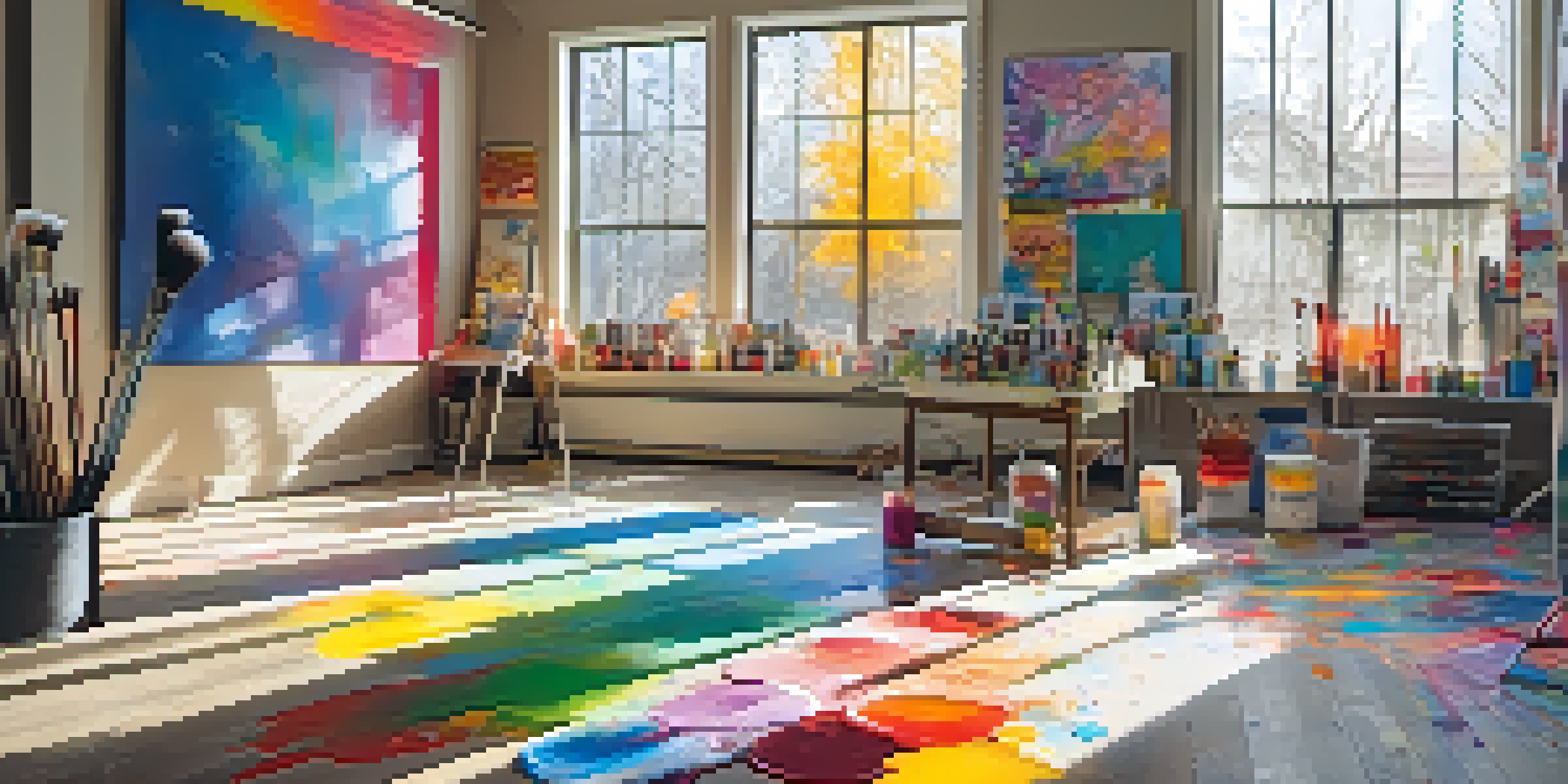Painting as a Means of Self-Expression for Teens in School

Understanding the Importance of Self-Expression for Teens
Self-expression is a vital part of adolescent development. During their teenage years, individuals are navigating complex emotions and identity formation, and finding healthy outlets is essential. Painting provides an avenue for teens to convey their thoughts and feelings visually, often when words fail them.
Art enables us to find ourselves and lose ourselves at the same time.
As teens face various pressures—from academic expectations to social dynamics—painting can serve as a therapeutic escape. It allows them to process their experiences and emotions, which can lead to increased self-awareness. Moreover, expressing themselves creatively can boost their confidence and help them feel more grounded.
In a world filled with social media and constant comparison, painting offers a refreshing break. Teens can create without the fear of judgment, making it a safe space for exploration. This ability to express themselves authentically can be incredibly empowering during a time when they are still figuring out who they are.
How Painting Fosters Emotional Intelligence in Teens
Emotional intelligence, or the ability to recognize and manage one’s emotions, is crucial for healthy relationships and personal well-being. Engaging in painting helps teens develop this skill by allowing them to explore and articulate their emotions visually. Each brushstroke can represent a feeling, creating a dialogue between the artist and their emotions.

When teens paint, they often reflect on their experiences, leading to greater empathy and understanding. For instance, a student might depict a personal struggle with anxiety through abstract art, helping them process their feelings and potentially connect with others facing similar challenges. This shared experience can foster a sense of community and support among peers.
Self-Expression Boosts Teen Growth
Engaging in painting allows teens to express complex emotions and navigate their identity, fostering personal development.
Furthermore, painting encourages introspection, which is key to emotional growth. As teens analyze their creations, they learn to identify the emotions behind their artwork. This practice not only enhances their emotional vocabulary but also equips them with tools to communicate their feelings more effectively in daily life.
Creating a Supportive Environment for Teen Artists
For teens to thrive in their artistic endeavors, a supportive environment is crucial. Schools can play a significant role by providing accessible art programs and materials that encourage creativity. When students feel encouraged to express themselves, they are more likely to engage in painting and other forms of art.
Every artist was first an amateur.
Moreover, fostering a culture of acceptance and appreciation for diverse artistic styles can enhance students' confidence. Encouraging students to explore their unique perspectives through painting can lead to a richer, more inclusive community. Schools can host art shows or exhibitions, showcasing students' work to celebrate their creativity and achievements.
In addition, providing mentorship opportunities, where older students or teachers guide younger artists, can create a positive feedback loop. This mentorship can help teens refine their skills while also fostering relationships that encourage ongoing artistic exploration. A nurturing environment can transform painting into a cherished outlet for self-expression.
The Therapeutic Benefits of Painting for Teens
Painting is not just a creative outlet; it's also a therapeutic practice that can significantly benefit teens' mental health. Engaging in artistic activities has been shown to reduce stress and anxiety, providing a calming effect during turbulent times. The act of painting can help teens channel their emotions in a productive way, promoting relaxation.
Research has demonstrated that art therapy can be effective in helping individuals manage mental health issues. For teens, painting can serve as a coping mechanism, allowing them to escape from daily pressures and express their innermost feelings. This therapeutic aspect of painting can lead to improved emotional regulation and resilience.
Painting Enhances Emotional Skills
Through painting, teens can articulate their feelings and build emotional intelligence, which is essential for healthy relationships.
Moreover, the sense of accomplishment that comes from completing a painting can boost self-esteem. As teens see their ideas come to life on canvas, they experience a sense of pride and achievement. This positive reinforcement can encourage them to continue exploring their creativity, further enhancing their emotional well-being.
Exploring Identity Through Art: A Journey for Teens
Adolescence is a critical time for identity exploration, and painting allows teens to express their evolving sense of self. Whether through abstract designs or self-portraits, art can reflect their personalities, beliefs, and experiences. This exploration can help them understand and embrace their unique identities.
For instance, a teen might create a series of paintings that represent their cultural background or personal struggles. This not only validates their experiences but also encourages dialogue with peers about identity and acceptance. As they share their work, they can inspire others to reflect on their own identities and experiences.
Additionally, painting can serve as a form of storytelling. By using colors, shapes, and themes, teens can communicate their journeys and perspectives. This narrative aspect of painting not only fosters self-discovery but also builds connections with others who may resonate with their stories.
Building Connections and Community Through Collaborative Art
Collaborative painting projects can strengthen relationships among teens and foster a sense of community. When students work together on a shared artwork, they learn valuable skills such as teamwork, communication, and compromise. These experiences can lead to lasting friendships and a supportive network.
For example, schools can organize mural projects where students come together to create a large-scale piece that reflects their collective identity or values. This not only beautifies the school environment but also instills a sense of pride among students. As they collaborate, they share ideas and insights, enriching their understanding of one another.
Collaboration Builds Community
Collaborative art projects promote teamwork and inclusivity, helping teens forge connections and strengthen their social networks.
In addition, collaborative art projects can bridge gaps between different social groups within a school. By working together, students from diverse backgrounds can connect through their shared creative process. This inclusivity fosters empathy and understanding, ultimately creating a more harmonious school environment.
Encouraging Lifelong Creativity: Lessons Learned Through Painting
The benefits of painting extend far beyond the classroom, instilling a love for creativity that can last a lifetime. By encouraging teens to express themselves through art, we empower them to embrace their creative instincts. This foundation can inspire a lifelong appreciation for artistic expression in various forms.
Moreover, the skills acquired through painting—such as problem-solving, critical thinking, and patience—are invaluable in many aspects of life. As teens navigate challenges, whether in academics or personal endeavors, the creative mindset they develop can help them approach situations with confidence and innovation.

Ultimately, fostering creativity through painting equips teens with the tools they need to thrive in an ever-changing world. Embracing artistic expression can lead to fulfilling careers, hobbies, and a deeper understanding of oneself. By nurturing their creativity today, we pave the way for a brighter, more expressive future.